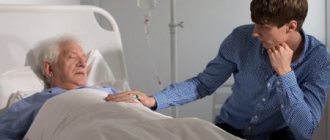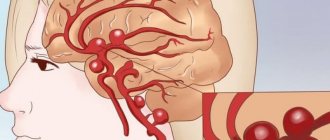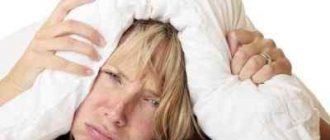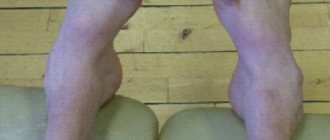Features of weakness in VSD
The physical and psychological nature of weakness is distinguished:
- The first occurs against the background of excessive physical exertion, when a person uses up all his energy reserves. The result of such activity is the inability of the muscles to work at an intense pace. At such moments, a person needs sound sleep and good nutrition. In the absence of pathological changes in the body, this is enough to normalize well-being and restore performance.
- Psychological weakness, which is typical for patients with VSD, has other features. A person exhausts himself with anxious thoughts, fears about the progression of the disease or the impossibility of curing it. In this case, the body loses energy not due to physical activity, but due to excessive worries. The desire to do anything disappears, followed by a deterioration in the patient’s condition, which further fuels his weakness. A “vicious circle” is formed.
Symptoms of VSD
With vegetative-vascular dystonia, the following signs of autonomic dysfunction occur:
- panic attacks;
- increase or decrease in blood pressure;
- heart rhythm disturbances;
- chills or sweating;
- increase in body temperature to 37.3°C;
- weakness in arms and legs;
- body aches.
Patients report that their hands are trembling, they constantly have “goosebumps all over their bodies,” and their arms and legs are “burning.” Twitching of the muscles of the face, upper and lower extremities, headache, nausea and vomiting, and pale skin occurs. Fainting often occurs, and patients continue to feel anxious. Often, darkening of the eyes and severe weakness with VSD occur with a sudden change in body position. When experiencing symptoms of VSD, a person begins to become afraid of them. This further enhances vegetative manifestations. A vicious circle is formed from which it is no longer possible for the patient to get out on his own. A person who has experienced a panic attack experiences fatigue, emptiness, lethargy, and drowsiness. In this case, psychotherapists from the Yusupov Hospital work with the patient.
Mechanism of weakness
Considering that the person suffering from dystonia is often to blame for the appearance of weakness, it is important to understand how the loss of energy resources occurs and how to cope with it.
The main source of energy that the body spends on performing physical and mental work is carbohydrates. During the process of glycolysis (decomposition), ATP molecules, lactic acid (lactate) and some other metabolic products are released.
- ATP is used as energy, and lactate and other substances are used to maintain homeostasis.
- Excess glucose that is not used is stored in the muscles and liver as glycogen. During physical activity, it is included in the metabolism and helps release energy.
There are several fundamental mechanisms that contribute to the occurrence of weakness in various forms of vegetative-vascular dystonia:
- lack of physical activity;
- malnutrition;
- anxious thoughts;
- disturbances in the functioning of the ANS, in this case causing the appearance of unpleasant symptoms of weakness, which is often combined with drowsiness.
The key factor remains the presence of physical activity, which activates energy metabolism. Of course, to replenish glucose reserves you need to eat well, but without sufficient work, muscles weaken. This leads to:
- fatigue;
- apathy;
- progression of classic symptoms of VSD.
During psychological “torment,” a person independently provokes the occurrence of pathological impulses in the cerebral cortex, which disrupts the functioning of the autonomic nervous system. This also aggravates the course of VSD.
By eliminating these factors, you will be able to improve your well-being and get rid of chronic weakness, fatigue and sleep disturbances. The main thing is to want to change your lifestyle. Remember: the mechanism of fatigue in dystonia is no different from normal, “biological” fatigue.
Is sleepiness treatable?
VSD is a kind of “failure” or malfunction in the autonomic nervous system. Weakness is also caused by autonomic-vascular dysfunction (abbreviated VSD) or cardio psychoneurosis.
As a result, in addition to drowsiness, two important functions of the body are disrupted:
- Mobilizing core systems to adapt to changing environmental conditions (stress, work, weather or climate change);
- Maintaining a constant internal environment (respiratory rate and heart rate, metabolic rate, sweating, body temperature, weakness, blood pressure).
Weakness in the legs
Severe muscle weakness in the legs is also on the list of common symptoms of VSD. Moreover, it is often experienced without objective reasons (physical overexertion, concomitant illnesses, etc.).
The main causes of muscle weakness in the legs due to dystonia, because of which doctors recommend spending more time on light physical activity:
- Excess lactic acid in muscles. During exercise and stress, glycogen (animal starch) breaks down in the muscles into glucose-6 phosphate, which is then converted into lactate, providing energy to the muscles themselves. Most of this energy goes to nourish the brain (up to 90%), which helps normalize well-being. But the accumulation of lactate in muscle tissue causes weakness and the familiar muscle pain after exercise.
- Disorder of the functioning of peripheral vessels. Against the background of VSD, the contraction and relaxation of veins and arteries is disrupted. This leads to blood stagnation with a feeling of heaviness and weakness in the legs.
- Disorder of the functioning of the ANS.
Weakness in the legs is only one of the signs of VSD, which can be treated with measured physical activity. The main thing is to choose the right individual set of exercises.
Situations are common when a patient with VSD comes to the therapist complaining of weakness in the legs. The doctor prescribes examinations, does not reveal any organic pathology and recommends doing light sports. Patients do not take such advice seriously and think that the doctor has not done enough diagnosis. They go to other doctors who advise the same thing. In the end, the person either realizes that the doctors are right, or begins self-medication. It’s easier for him to deny that he’s healthy, because feeling sorry for himself is so comfortable! This allows you to attribute all life’s failures to an imaginary illness and cultivate it.
Specifics of drowsiness
Subjective feelings of patients with VSD about drowsiness are often very vivid and strong, which makes them suspect that they have a serious and incurable disease. In fact, VSD is a completely reversible benign disease. At the same time, young people can “wind up” themselves and become so immersed in imaginary drowsiness that they forget about everything in the world and focus only on their weakness.
There is even such a serious disease that appears against the background of manifestations of VSD. This disease sometimes appears in teenage children who have “outgrown” their age and are an order of magnitude taller than their peers. This disease is known as “Dissociative Conversion Disorder” or “Cerebral Angiodystonia Syndrome.” A completely healthy child feels drowsy and feels weak in the legs and throughout the body almost constantly. Basically, such children stop moving and crawl. The teenager withdraws into himself and rarely goes outside. Parents have to purchase a wheelchair so that the child can somehow go outside. There is usually no cure for this condition. Doctors say drowsiness and muscle weakness should go away on their own when the growth and riot of hormones stops (at 9 years old, the hormone levels in such children are much higher than in adults). There is practically no information about treatment.
Differential diagnosis
Despite the fact that weakness is a constant symptom of dystonia, differential diagnosis is still needed. The fact is that this symptom is nonspecific and accompanies a number of other diseases.
Before advising you to go in for sports, the doctor will conduct a full examination of the patient using additional examinations:
- careful collection of anamnesis and analysis of complaints;
- physical examination;
- clinical blood test;
- biochemical blood test (creatine phosphokinase level);
- muscle biopsy (if hereditary myopathies and amyotrophies are suspected);
- ECG;
- fluorography.
The diagnostic program is expanded if there is a suspicion of a specific disease causing weakness. It all depends on the individual characteristics of the person and genetic predisposition. In some cases, based on the family nature of the cases, it is possible to make a diagnosis of a rare hereditary pathology.
How to solve a problem?
If you feel weak in your legs when walking, coupled with a constant feeling of fear for your life, try to correct the situation with these tips:
- Twice a day, do simple exercises for your legs - squats. With your feet shoulder-width apart, hold onto something stable and squat at a brisk pace. You will need to perform 10 squats in each of 3 sets.
- Take walks at any time, in any weather. This will strengthen your heart, leg muscles and mood.
- Take a contrast shower - the vessels will learn to adapt to rapidly changing environmental conditions and will react less to outbreaks of VSD.
- Stop lying or sitting for hours. At least once an hour, get up and just walk around the room. You can pump up your abs or do squats, the main thing is to keep your body in good shape.
- To make the ligaments and muscles of your legs feel comfortable, bend over and touch your toes to the floor. Try to hold the incline for at least 5 minutes.
And most importantly, stop tormenting yourself with fictitious diseases and expecting miracles from nowhere. All the most wonderful things are always nearby, in our hands. Start the right lifestyle today, and soon your legs will thank you with vigor and strength.
Treatment recommendations
In the treatment of weakness caused by disturbances in the functioning of the ANS, drug and non-drug methods are used.
In the first case the following applies:
- specialized drugs aimed at improving metabolic processes in the brain;
- sedatives;
- drugs that stimulate the functioning of the autonomic nervous system (for the hypotonic type of VSD).
In non-drug therapy, the best results are demonstrated by the following methods:
- dosed physical activity;
- yoga;
- physiotherapy;
- correction of daily routine and diet;
- auto-trainings.
Integrated use of these treatment options improves well-being faster and eliminates weakness in the body.
Physical activity and yoga
The selection of highly targeted exercises is carried out after consultation with a doctor or professional trainer who knows how to work with dystonics.
- In the initial stages, normal walking will do. This helps harmonize the functioning of the ANS in hyper- and hypotonic types of the disease, which makes it universal. To normalize your well-being, it is recommended to walk 10-60 minutes a day.
- The equivalent of walking is swimming in a pool. This load involves all muscle groups in the body, fights psychological fatigue and improves mood.
- Yoga is a set of physical and psychological practices designed to harmonize the human condition. In case of VSD, performing asanas with breathing control and psychological training helps to quickly eliminate weakness.
In the initial stages, it is better to train under the supervision of a professional trainer.
How to calm down
Although the condition returns to normal within 15-80 minutes, sedatives are used to restore breathing - Glyciside, Anaprilin, Gidazepam. Alternative treatment includes:
- drinking water with sugar;
- relaxation in the shower.
A destructive condition, sweating removes the balance of carbon dioxide. To do this, inflate a bag or ball or breathe into a funnel from your palms. To tone the brain, read poetry by heart. A warm shower is helpful.











